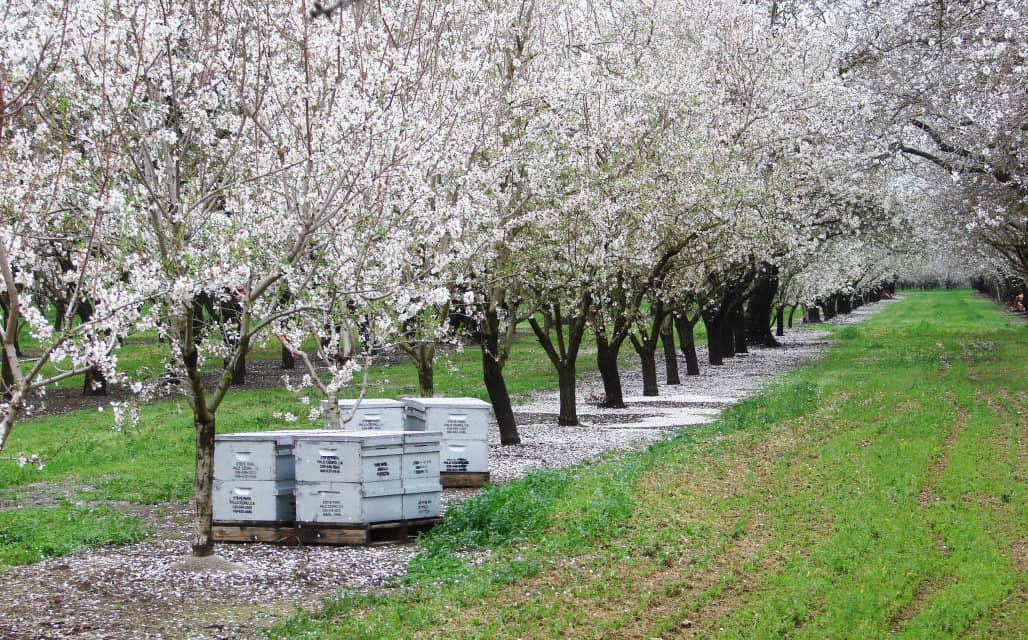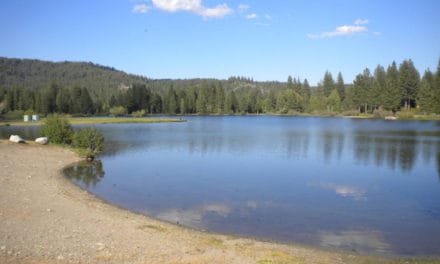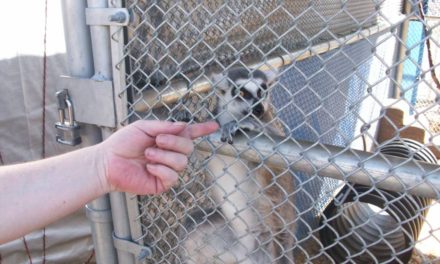FARMERS PARTNER WITH NATURE FOR AN IMPRESSIVE SHOW
Article and Photos By Debra Hasbrouck
If you’re looking for a good way to shake the winter doldrums, consider a tour around the Durham almond orchards during bloom season. Approximately seven miles south of Chico, Durham is in the heart of Butte County almond country. Typically starting in mid-to-late February, the almond buds erupt into a spectacular display of pale pink to white flowers, filling the air with the intoxicating aroma of spring.
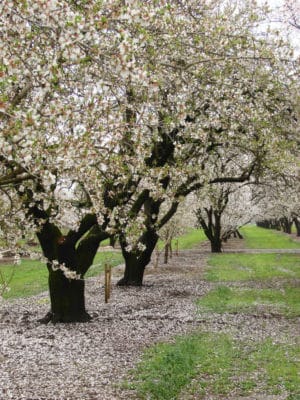
The weather has an immense effect on when the buds open, so the optimum time for a rewarding blossom drive can involve a bit of guesswork. Sometimes warm weather will come early and everything will bloom at once. However, it’s much more common for the buds to open in a measured manner. Even on a single tree there may be early bloomers mixed in with leisurely stragglers.
People often wonder why they might see an entire row of trees in magnificent bloom, while the row next to it is just starting to wake up. Since the main crop, Nonpareil almonds, are not self pollinating, other varieties are needed for fertilization. Although Nonpareils usually make up half of an orchard, there are often early bloomers and mid-to-late bloomers planted in alternating rows. This increases the chance that every Nonpareil blossom will receive a cross-pollination visit from the bees.
Honeybees are essential partners for successful pollination, with most farmers renting them from an apiarist, or beekeeper. While driving around the orchards you may notice the beehives, which are housed in light grey or white boxes. The bees are eager to visit those gorgeous blossoms, especially since almond flowers provide some of the first natural forage after winter.
Most of us have heard in the news about a global decline in bee health. It is a worldwide dilemma that is of great concern to local almond farmers. Since 1976, the California Almond Board has funded research to help support and protect bees. One association they have partnered with is Project Apis m. or PAm. In addition to research and education, PAm has implemented a project where they donate seed mix to almond farmers for planting “floral diversity buffer zones.” Occasionally, you may see these areas of early flowering plants bordering the almond orchards.
After the bees have done their work, the beautiful almond blossoms should quickly develop into gelatinous little nutlets, which are very susceptible to severe cold. If you see irrigation sprinklers running in February or March, it’s probably for frost protection.
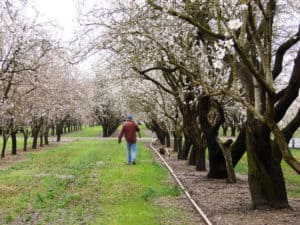
When all goes well, the almonds will grow inside their hulls and eventually be ready for harvest, usually starting in August and finishing in October. Local almonds are an important part of California agriculture, providing a nutritious food for the United States as well as the world. According to Dani Lightle, the Orchard Farm Advisor for Butte, Glenn and Tehama Counties, the 2013 almond crop value for Butte County was approximately $196 million. She stated that, “California produces about 80% of the world’s almonds, with 30% sold domestically and 70% shipped internationally.”
In addition to boosting our economy and providing jobs, the almond industry is committed to sustainable practices. The California Almond Sustainability Program (CASP) is an effort to improve the use and management of water, land, energy, and air quality. According to the Almond Board website, “Over the past 20 years the amount of water they use per pound of almonds is down by 33%.”
For farmers it’s not just a Job – it’s a way of life, as they strive to be good stewards of the land. From their hard work and a partnership with nature, comes the stunning show of countless blossoms decorating Durham almond orchards in February.
As you meander along the little roads surrounding Durham, be aware that it’s a busy time of year for almond farmers and people are working throughout the orchards. Also, remember that the orchards are private property and represent someone’s livelihood.
So bring your camera, enjoy the drive and breathe in a little promise of spring.
FOR MORE INFORMATION:
The Chico Chamber of Commerce has blossom tour maps. They are located at 441 Main Street in Chico. Website: www.chicochamber.com. Ph: (530) 891-5556.
The California Almond Board has information about almond history and production, a “Bee Active” page, nutrition education, storage tips and recipes on their website at: www.almonds.com.
Project Apis m. a non-profit with a mission to “fund and direct research that will enhance the health and vitality of honeybees while improving crop production.” Website: www.projectapism.org
Bee Informed Partnership (BIP) is a national organization dedicated to honeybee health on a large scale across the country. Wensite: www.beeinformed.org.
FOOD, LODGING AND MORE:
If smelling all those blossoms works up an appetite, there are some great places to eat in Durham. Serving breakfast and lunch, The Red Rooster is near the middle of town at 9418 Midway and is open Monday through Saturday from 6 a.m. until 2 p.m. The Chatterbox Café is located just west of the center of town, at 2500 Durham-Dayton Highway next to the intersection of Burdick Road. You can stop in for a cup of coffee and some homemade bakery items, or sit down for breakfast or lunch, Monday through Friday from 6 a.m. to 2 p.m. and Saturday from 6 a.m. to 11 a.m.
The Durham Community Park is a great place to stretch your legs and have a picnic. Underneath some very impressive Oak trees, there are picnic tables, a playground, basketball courts and restrooms that are open year-round, sunrise to sunset. It is located about one mile east of town at 1847 Durham-Dayton Highway. The Durham Recreation and Park District website is: www.durhamrec.com
For local lodging, the Durham House Inn is a bed and breakfast located just east of town at 2280 Durham-Dayton Highway. The house, an Italianate Victorian built by W. W. Durham in 1874, is decorated with Victorian furniture and surrounded by beautiful grounds. They serve their guests a full gourmet breakfast and offer satellite TV and wireless access. Their website is: www.durhamhouseinn.com
The annual Almond Blossom Run is open to the public and has a course that winds through the orchards. They will have 5K and 10K runs, as well as a 5K walk on Sunday, February 22, 2015. The event is the main fundraiser for the athletic programs at the Durham Intermediate and High Schools. If interested in participating, their website is: www.durhamsportsbooster.com and you can find them on Facebook under “Durham Almond Blossom Run.”

